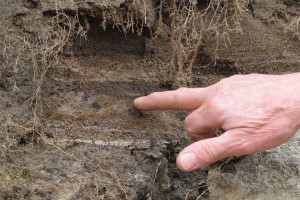Soil classification illustrations
In this section
-
Visiting Te Rauhītanga – The Gathering Place
- Kōwhaiwhai
- A story of Haumia Tiketike – He kōrero mō Haumia Tiketike
- A story of Rongo – He korero mō Rongo
- A story of Tāne – He kōrero mō Tāne
- Carvings – Whakairo
- The names of our buildings
- The names of our meeting rooms
- Virtual reality: Karanga a Tāne Mahuta
- Rene Orchiston Flax Collection – He Kohinga harakeke nā Rene Orchiston
- Banks and Solander prints
- Invertebrate illustrations
- Biodiversity display
- Weed and predator control display
- Land video wall
- Historic soil maps
- Soil classification illustrations
- Augmented reality sandpit
- Beech tree cores
Dr Hewitt explains the need for such a system:
"This [soil] variation is a source of endless fascination to the scientist, but it can be confusing to someone seeking to gain a broad understanding of New Zealand soils in relation to landscapes and land uses. This is where soil classification can provide a sense of the underlying order and pattern needed to assist understanding of New Zealand’s soils and their landscapes."
The relative degree of soil development (horizonation and soil structure) and the degree of alteration of the original rock material or sediments are key factors. Soil colour can provide clues about soil processes and properties: the darkness of topsoil relates to its organic carbon content, grey subsoil can indicate waterlogging, pale-coloured subsoils reflect weak weathering whereas bright red colours indicate prolongued weathering, and white horizons can be the result of intense leaching.
Soil classification generates new knowledge and provides a platform for further research.
![Stylised drawings of the soil groups of the New Zealand Soil Classification (NZSC) used today. Click to enlarge [opens in a new window] Stylised drawings of the soil groups of the New Zealand Soil Classification (NZSC) used today. Click to enlarge [opens in a new window]](/assets/About-Us/te-rauhitanga/soil-profiles__ResizedImageWzg3MCw4MjBd.jpg)
